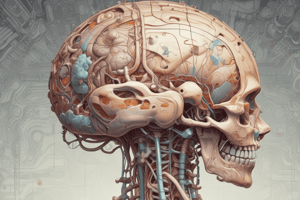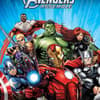Podcast
Questions and Answers
What primarily makes up the white matter in the central nervous system?
What primarily makes up the white matter in the central nervous system?
- Cell bodies and blood vessels
- Synapses and neurotransmitters
- Unmyelinated somas and dendrites
- Myelinated axons (correct)
Which part of the spinal cord is responsible for controlling the limbs?
Which part of the spinal cord is responsible for controlling the limbs?
- Lumbar region (correct)
- Thoracic region
- Cervical region (correct)
- Sacral region
What is the primary role of the spinal cord in terms of reflex actions?
What is the primary role of the spinal cord in terms of reflex actions?
- To process sensory information before sending it to the brain
- To store memories related to motor functions
- To initiate a response to a stimulus without brain input (correct)
- To enhance cognitive functions during voluntary movements
Which of the following accurately describes the organization of the spinal cord segments?
Which of the following accurately describes the organization of the spinal cord segments?
What is one of the primary functions of the brain as described in the content?
What is one of the primary functions of the brain as described in the content?
What is the primary function of the midbrain?
What is the primary function of the midbrain?
Which structure is NOT involved in involuntary functions in the medulla?
Which structure is NOT involved in involuntary functions in the medulla?
What role does the cerebellum play in motor activity?
What role does the cerebellum play in motor activity?
Which of the following is a primary role of the thalamus?
Which of the following is a primary role of the thalamus?
Which area of the brain is primarily involved in the regulation of homeostasis?
Which area of the brain is primarily involved in the regulation of homeostasis?
Which nuclei are part of the basal ganglia?
Which nuclei are part of the basal ganglia?
What is the main role of the reticular formation?
What is the main role of the reticular formation?
Which statement is true about the structure of the pituitary gland?
Which statement is true about the structure of the pituitary gland?
What effect does damage to the RAS have on an individual?
What effect does damage to the RAS have on an individual?
Which lobe is NOT one of the four lobes of the cerebrum?
Which lobe is NOT one of the four lobes of the cerebrum?
Flashcards are hidden until you start studying
Study Notes
CNS Anatomy
- Central Nervous System (CNS): Composed of brain and spinal cord.
- Gray Matter: Contains unmyelinated cell bodies, dendrites, and axons.
- White Matter: Primarily composed of myelinated axons.
Spinal Cord
- Spinal Cord: Major pathway for information flow between the brain and the body (skin, muscles, joints).
- Regions: Divided into cervical, thoracic, lumbar, sacral, and coccygeal segments.
- Spinal Nerves: Each segment gives rise to a pair of spinal nerves, which split into roots:
- Dorsal Roots: Carry sensory information into the spinal cord (afferent).
- Ventral Roots: Carry motor information out of the spinal cord (efferent).
- Nuclei: Clusters of neuronal cell bodies within the CNS.
- Ganglia: Clusters of neuronal cell bodies within the peripheral nervous system (PNS).
Spinal Reflexes
- Spinal Reflexes: The spinal cord can initiate a response to a stimulus without input from the brain.
- Importance: Crucial for body movement, enabling rapid responses to stimuli.
Brain
- Brain: The organ responsible for complex cognitive functions and human attributes.
- Structure: Weighs around 1.4 kg, contains 85 billion neurons with thousands of synapses.
- Major Divisions:
- Cerebrum
- Cerebellum
- Diencephalon
- Medulla
- Midbrain
- Pons
Brainstem
- Brainstem: The oldest and most primitive region of the brain, consisting of:
- Medulla
- Pons
- Midbrain
- Function:
- Relays ascending and descending tracts.
- Contains 11 out of 12 cranial nerves, responsible for head & neck sensory and motor information.
- Contains nuclei involved in basic bodily functions, including sleep-wake cycles, muscle tone, breathing, blood pressure, and pain modulation.
Medulla
- Structure: Contains ascending (sensory) and descending (motor) tracts.
- Function:
- 90% of corticospinal tracts decussate (cross over) at the pyramids.
- Control of involuntary functions, including cardiovascular and respiratory centers.
- Contains centers for vomiting, swallowing, coughing, sneezing, and hiccupping.
Pons and Midbrain
- Pons:
- Contains nuclei and tracts responsible for relaying information between the cerebellum and cerebrum.
- Assists the medulla in regulating breathing.
- Midbrain:
- Connects the lower brainstem to the diencephalon.
- Primary control center for eye movement.
- Relays auditory and visual reflexes.
- Contains the substantia nigra.
Reticular Formation
- Reticular Formation:
- Network of neuronal cell bodies distributed throughout the brainstem.
- Involved in:
- Consciousness, arousal, attention
- Sensory information filtering
- Muscle tone regulation
- Vital function control
Cerebellum
- Cerebellum: Second largest brain structure consisting of two hemispheres.
- Function:
- Processes sensory information and coordinates movement execution.
- Sends feedback signals to the cerebral cortex to correct movements and ensure smoothness.
- Regulates posture and balance.
Diencephalon
- Diencephalon: Region located between the brainstem and cerebrum.
- Structures:
- Thalamus: Relay center for sensory and motor information to the cerebrum.
- Hypothalamus: Homeostasis control center, influencing autonomic and endocrine functions.
- Endocrine Structures:
- Pineal gland: Produces melatonin, involved in sleep-wake cycles.
- Pituitary gland: Anterior and posterior lobes contribute to endocrine function.
Pituitary
- Pituitary Gland: A key player in the endocrine system, receiving control from the hypothalamus.
- Posterior Pituitary: Neural tissue storing and releasing hormones produced by the hypothalamus.
- Anterior Pituitary: Endocrine tissue that releases hormones under hypothalamic control.
Cerebrum
- Cerebrum: Largest and most distinctive part of the brain.
- Gray Matter: Contains:
- Cerebral cortex: Responsible for higher-level processing
- Basal ganglia: Regulate movement initiation and termination
- Limbic system: Involved in emotions and motivation
- Hemispheres: Two hemispheres connected by the corpus callosum.
- Lobes: Each hemisphere divided into four lobes: frontal, parietal, temporal, occipital.
Basal Ganglia
- Basal Ganglia: Group of nuclei (globus pallidus, putamen, caudate nucleus) responsible for movement regulation.
- Function:
- Receives input from the cerebral cortex
- Provides output to motor areas of the cortex.
Limbic System
- Limbic System: Often referred to as the "emotional brain."
- Function:
- Controls a wide range of emotions including pain, pleasure, docility, affection, and anger.
Studying That Suits You
Use AI to generate personalized quizzes and flashcards to suit your learning preferences.





